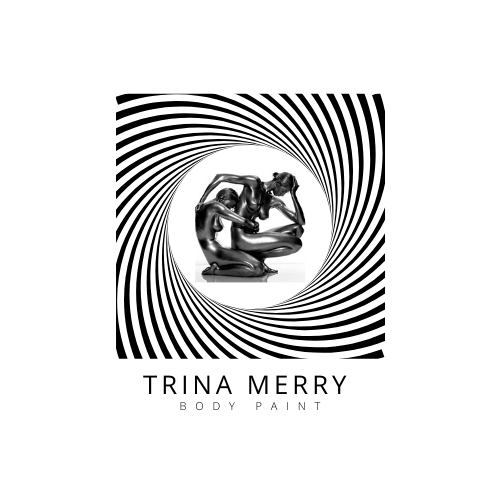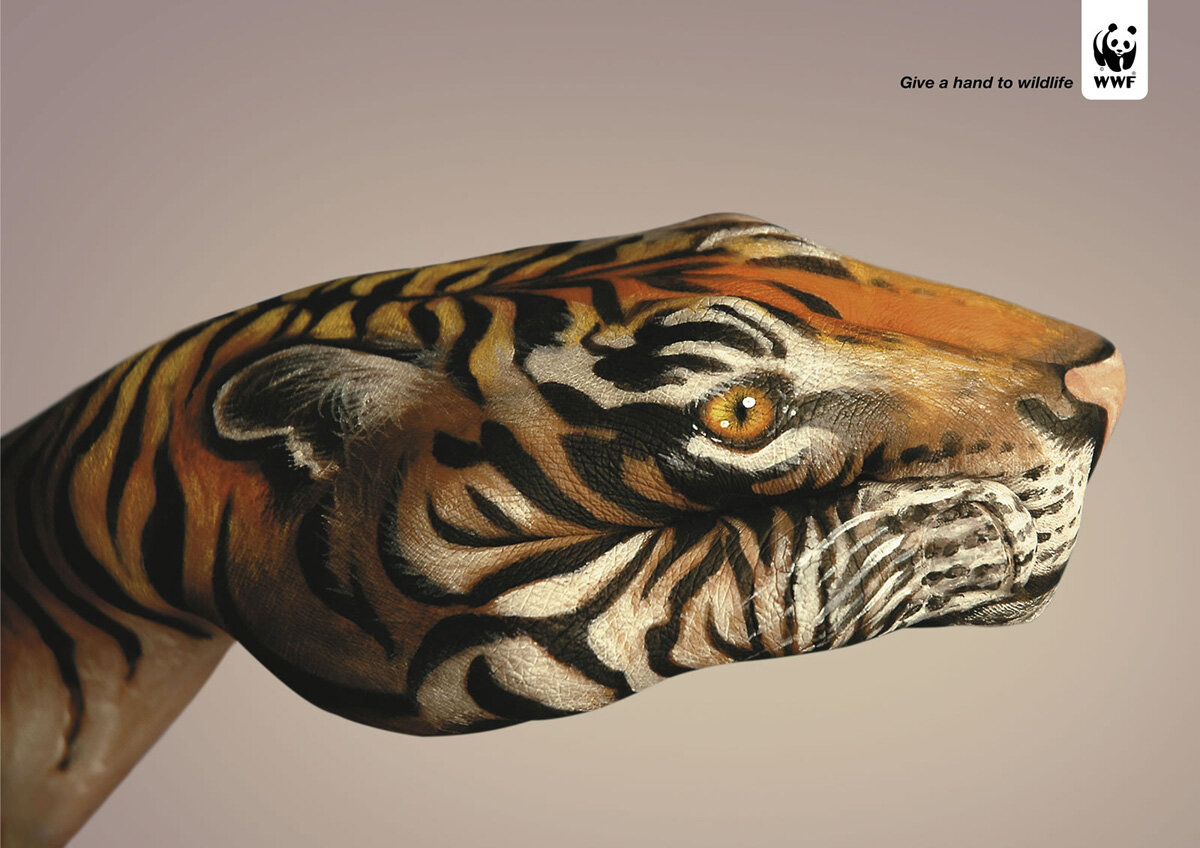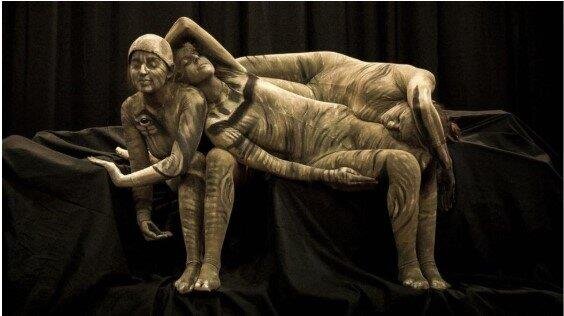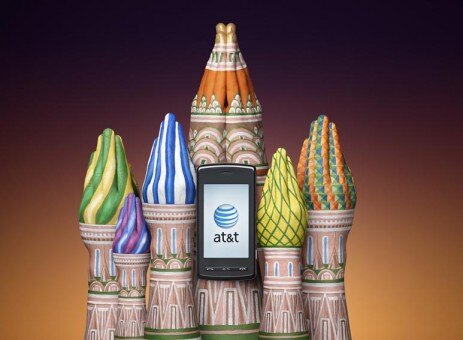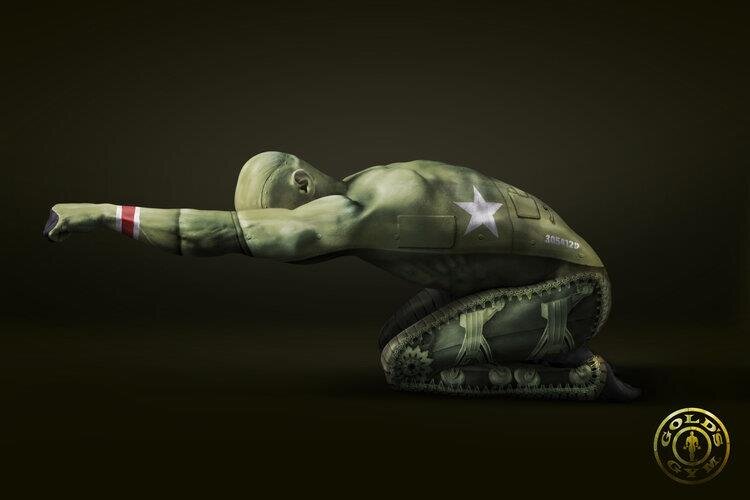As the world of marketing becomes increasingly complex and competitive, brands must seek ways to differentiate themselves and their products. However, simply doing bold campaigns for the sake of being trendy and audacious is not always enough to gain the trust of potential buyers. Nowadays, consumers want to support brands that are relatable, authentic, and creative. Consumers want to see bits of themselves reflected in brand campaigns before even buying the product or service. With this being said, advertisers must seek out new ways to peak interest, drive conversation, and relate their brand to humanity.
One interesting way brands can achieve these goals is through the use of body paint art campaigns. Body painting is a dynamic medium that continues to gain popularity with its whimsical use of our human bodies. Although many of us may think of body painting as the times we got our faces painted as children, contemporary body paint art encompasses much more than playful paintings upon our skin. Modern body painting has the dynamic ability to tell stories. By relating shapes, colors, objects, and themes to the human form, body paint can humanize even the most abstract concepts. This unique characteristic is one that should not be overlooked by advertisers; body painting may be one of the most dynamic storytelling tools available. This article will dive into the history of body paint advertising as well as examples of some of the most successful body paint advertisements done by major organizations.
A brief introduction to body paint art
Before we uncover how body paint art can fulfill advertising objectives, it is important to define what body painting even is. According to the Merriam Webster dictionary, body paint can be defined as “paint applied to a person’s body”. The act of painting one’s body can be traced back to indigenous people across all major continents. Body painting was a practice originally done to signify an important detail about a man or a woman. Social status, spiritual meanings, and tribal responsibilities were all different traits that could be conveyed through body art. By using natural dyes derived from plants, fruits, and pigments, indigenous people could temporarily alter their skin. Ultimately, ancient cultures around the world used body paint as a way to define who they were.
Like most artforms, body painting has evolved tremendously from its primitive origins. Body paint itself is no longer limited to naturally derived pigments. Body painters can now choose from an array of tools ranging from makeup to skin-safe silicone paint. Additionally, contemporary body painting has evolved into an artistic vehicle that allows free artistic expression. Body painters are no longer constrained to conveying ideas only about the person they are painting. Instead, modern body paint artists can use their human canvases to make statements about society, illnesses, nature, and even themselves. In fact, many body paint artists do not limit themselves to even one human canvas and instead use a multitude of human models to communicate an idea. Since contemporary body art typically uses temporary paints, it can be captured through photography, installations, and performances.
What’s especially unique about contemporary body paint art is the fact it incorporates a human body into the composition. Like most forms of art, body painting can be used to explore almost any idea. However, by using the human form within their body paint art or performances, body paint artists allow for others to relate to the humanity that their compositions bring. For example, a realistic painting of landscape on a traditional canvas will not typically leave its audience with questions about the scene or their relationship to it. Painting a landscape onto a human, however, creates a different reaction. That landscape is now recognized as human, and we unconsciously begin to relate to the artwork at an empathetic level. Humans are naturally wired to look for patterns and humanistic qualities in non-human objects, and body paint art allows that human element to bring deeper meanings and engagement into the subject matter. Body painting is so special because it is bringing art to life and allowing the human body to tell countless stories.
The history of body paint art in advertising
Although body paint has had a rich history, advertisers have only begun to utilize the art form fairly recently. The first marketing stunt done with body paint was at the 1933 World’s Fair in Chicago. Here is where cosmetic entrepreneur Max Factor Sr. shocked the world by painting the nude body of burlesque star, Sally Rand. Although this body painting brought lots of attention, it was deemed too controversial for that era’s ultra-conservative society. In fact, Sally Rand and Max Factor Sr both got arrested for the display. Luckily, the psychedelic seventies popularized body painting as a form of personal expression.
Image of Max Factor Sr’s body paint work done on burlesque star Sally Rand (1933)
Suddenly, in the nineties, brands began to experiment with body paint stunts again. As they were no longer worried about offending a conservative society, magazines particularly embraced the artform. In the famous 1992 edition of Vanity Fair, Demi Moore graced the magazine’s covers with a body painted suit done by body paint legend, Joanne Gair. In 1999, Sports Illustrated hired Gair to paint swimsuits on models for their swimsuit edition. The body painted swimsuits proved to be widely popular and are still featured in Sports Illustrated today. Bold stunts such as these inspired artists across the world to explore the art form. Nowadays, there are a wide range of body paint artists each specializing in their own unique styles and aesthetics.
Demi Moore’s Vanity Fair “Birthday Suit” cover by Joanne Gair (1992) Image Source: Wikipedia
Modern examples of body paint in advertising campaigns
Below is a list of the top 20 modern body paint advertisements. We gathered examples from various industries to demonstrate how versatile body painting can be. From car companies to nonprofits, organizations across the world are understanding the impact body paint art can have. Although body painting may be seen as risque or “too sexy”, a skilled body paint artist will understand how to apply the human body in a way that best fits the message that a brand is trying to convey. Many of the examples below show that it is not necessary to have nudity or even full bodies shown at all. These examples will further emphasize how versatile, flexible, and impactful body painting is.
1.) World Wildlife Fund
The World Wildlife Fund (WWF) is one of the organizations that frequently uses body paint to spread its message about wildlife preservation. By using campaigns featuring only human hands to several painted humans, WWF reminds everyone of the human-like qualities all animals have. In 2012, the WWF teamed up with Guido Daniele to turn hands into wild animals. These images have been some of the most well-known examples of body paint art even to this day. In 2016, the WWF utilized body painting again to spread awareness of illegal ivory trading. This time, body paint artist Johannes Stoetter turned three models into an elephant with the hopes that people would understand the risk these intelligent animals face. This particular example highlights how even nonprofits can utilize body paint to educate others about their cause.
Guido Daniele’s “Give a Hand to Wildlife” Campaign. Image Source: Wabbaly
Advertising Agency: Saatchi & Saatchi Simko, Geneva, Switzerland
Creative Director: Olivier Girard
Art Director: Nicolas Poulain
Copywriter: Jean-Michel Larsen
Body painter: Guido Daniele
Information Source(s): Wabbaly
Johannes Stoetter’s “Coming Together for Elephants”. Image Source: BBC
Body painter:Johannes Stoetter
Information Source(s): BBC, National Geographic
2.) Air New Zealand
Air New Zealand’s “Nothing to Hide” campaign highlights how copywriting and body paint can create brilliant advertising. The airline wanted to show that it does not charge for extra services the way its competitors tend to do. The campaign included snapping photos of various airline workers doing their jobs in the flesh. Pilots, baggage loaders, and flight attendants had their typical work uniform painted on their skin to become the poster children of the campaign. What is extra special about the “Nothing to Hide” campaign is that it also included a new safety video in which all the instructors were also body painted. The video shown to passengers during take off, and it certainly created a buzz!
Poster for Air New Zealand’s “Nothing to Hide” campaign. Image Source:The Inspiration Room
Advertising Agency: .99
Executive Creative Director: Craig Whitehead
Deputy Creative Director: Nicolas Poulain
Art Director: Janelle Herrick (nee Olsen)
Copywriter: Lara Philips
Agency Producer: Vicky O’Leary
Film Director: Kevin Denholm via Exposure Films, Auckland
Information Source(s): The Inspiration Room
3.) Nestle Coffee
Nestle recently did a body painting stunt that highlights one of the major themes that can come through with body paint: all-natural. To advertise their new, all-natural coffee creamer, Nestle painted employees of a Manhattan coffee shop. Visitors were in disbelief when they suddenly realized that their baristas’ apron and shirts were all an optical illusion made with body paint. However, the reception was positive overall. Nestle posted a video of their stunt, and it went viral with over 2.3 million views.
Best of all, the patrons’ Nestle-creamed coffees were free (which turned out to be more unbelievable than the body painted baristas).
Screenshot from Nestle’s ‘All Natural’ Creamer campaign. Image Source: NY Daily News
Advertising Agency: 360i
Chief Creative Officer: Pierre Lipton
Information Source(s): NY Daily News
4.) Ford
The Ford Focus “Go Green” Campaign is a great example of how body paint can apply to objects beyond the human body. Ford partnered with Trina Merry, a body paint artist known for her camouflage body paint art. The artist painted singer Jason Mraz, actress Felicia Day, and lifestyle guru Rainbeau Mars next to a Ford Focus Vehicle. Both the electric cars and each model were painted into their natural landscape thus creating an intriguing illusion. This campaign demonstrates that products can be incorporated into the body paint design of an advertisement. Additionally, the “Go Green” campaign shows how body paint can explore topics about our relationship with nature.
Jason Mraz and Ford Focus painted by Trina Merry. Image Source: Trina Merry
Advertising Agency: The Audience
Body painter & Photographer: Trina Merry
Ford continued to promote its environmental values through body paint in a different campaign. As a way to advertise for the Ford Environmental Conservation Award, the automotive company used face painting, hand painting, and food to make a statement about helping nature.
Advertising Agency: JWT, São Paulo, Brazil
Creative Directors: Mario D’Andrea, Roberto Fernandez
Art Director: Sthefan Ko
Copywriter: Fabio Leao
Photographer: Regis Fernandez
Illustrator: Sthefan Ko
5.) Coors
The alcohol industry uses body paint in their advertising campaigns fairly frequently. Coors Light Beer teamed up with body paint artist Filippo Ioco to blend in three models on a can of their beer. The iconic Coors logo was seamlessly painted onto the models, and the human canvases were also painted to look like they were made out of the same metallic texture of the beer can. This particular piece shows how body paint art can incorporate more than just flat colors; there are ways to include iridescent shimmers, glitter, and metallic texture into body paint art.
Coors Light Beer- “Human Can” done by Filippo Ioco. Image Source: Filippo Ioco
Body Painter:Filippo Ioco
6.) BayerAspirin
In an effort to spread awareness and education about the risks of heart attacks, Bayer hired body paint artist Alexa Meade to paint three heart attack victims. Alexa Meade’s uses a style that makes her subjects and their backgrounds appear like they are part of a painting. Bayer’s campaign then went even further by allowing social media users to use an augmented reality filter to put themselves into Meade’s paintings. Bayer’s recent campaign shows advertisers that brands can combine body paint, technology, and social media to create an interactive, engaging, and informative marketing tool.
Bayer’s #YourHiddenRisk campaign painted by Alexa Meade. Image Source: Mmm-Online
Body Painter: Alexa MeadeInformation Source(s): Mmm-Online, New Kerala, Your Hidden Risk
7.) Delta Faucets
In order to advertise the effectiveness of their In2ition Shower Heads, Delta Faucets used body paint in a really unique way. Instead of highlighting their product by putting body paint on models, Delta’s campaign took a different direction. Body painted men used the Delta Faucets to take their painted outfits off. This campaign also used a video to capture how quickly the paint melted off the models. Delta’s campaign shows how body paint can be viewed through different angles. Like Delta, some products may have a more effective campaign by taking body paint off. Consider the message you want to send and think of the different ways body paint can be used to communicate it.
Creative Agency: Young & Laramore
Information Source(s): iSpot.tv
8.) Pampaverde
Pampaverde, a Chilean meat company, used body paint to exaggerate the size of their products. By painting a giant mouth across a model’s face and neck, Pampaverde was able to exaggerate the size of their “extra big” frozen burgers. This is an excellent example of how intentional body paint can be used to convey the scale of a product and how our bodies relate to it.
Advertising Agency: La Mesa (Santiago, Chile)
Executive Creative Director: Sebastián Katz
Creative Director: Sebastián Katz
Art Directors: Jorge Llewellyn, Cristian Toffolo
Copywriter: Cristián Zarzar
9) Nestseekers International
Consider the case of Ryan Serhant and the property and real estate firm, Nestseekers International, was attempting to sell. By working with body paint artist Trina Merry, a body paint advertising campaign was devised to create buzz about the property. The real estate firm even went one step further by pasting a giant copy of Merry’s art against the wall of the building and in Times Square. Once the images went public, Ryan states that “everyone noticed and then we broke price records”. Even in an industry that is typically not known for its creativity, this artistic advertising campaign captivated attention around the world.
Trina Merry’s work for Nestseekers International “100 Avenue A”. Image Source: Trina Merry
Sales and Marketing: Nestseekers
Exclusive Sales Agent:Ryan Serhant
Architect:Isaac & Stern
Branding and Graphic Design: IF Studio
Body Painter: Trina Merry
Developer: Magnum Real Estate Group
Interior Design: Built In Studio
10.) NY Magazine-My Living Election Map
Even politics has a seat at the body paint table! During the 2016 presidential elections, New York Magazine live-streamed artist Trina Merry body painting models with the outline of all 50 US states. Almost like a human-shaped coloring book, Merry painted in each state red or blue once the electoral votes had been released. This campaign shows that body painted can even be used to live stream important information. Instead of competing with major news stations all reporting the same news in the same format, New York Magazine went a more artistic route. Those watching the live stream still got the same voting results coverage, but they were able to sit, watch, and enjoy the live painting regardless of the party they identified with. Over half a million people watched the video on Facebook, and it received over 3,800 comments and over 1,000 shares.
“2016 Election Map” By Trina Merry. Image Source: Trina Merry
https://www.facebook.com/NewYorkMag/videos/10154727454929826/
Body Painter: Trina Merry
Photographer: Bertrand Orsal
11.) AT&T
In 2008, AT&T wanted an effective way to advertise their international roaming services. The cellular service provider used the talents of Guido Daniele’s hand paintings to relay the news to the world. What’s especially interesting about this campaign is how the hands are holding cell phones while they are painted to look like famous landmarks and animals from countries around the world. This genius juxtaposition created a buzz, and the campaign was voted as ‘America’s Favorite Magazine Ad’ by consumers. Here is another example of how body paint can be used in conjunction with products or props to further enhance the message a brand is attempting to say.
AT&T “Hands” campaign done by Guido Daniele. Image source: If it’s Hip, It’s Here
Advertising Agency: BBDO Atlanta, BBDO New York
Chief Creative Officers: David Lubars, Bill Bruce
Exectuive Creative Director: Susan Credle
Creative Directors: Rich Wakefield, Chuck Meehan
Art Director: Biran Locascio
Copywriter: Bridget Prophet
Body Painter: Guido Daniele
Photographer: Andric
Awards: Voted ‘America’s Favorite Magazine Ad’ by Consumers, Magazine Publishers of America
Information Source(s): It it’s Hip, It’s Here
12.) Centro de Valorização da Vida (Sucidie Prevention Center-Brazil)
Serious topics like mental health can also spread awareness through body paint. The Centro de Valorização da Vida (a Suicide Prevention Center in Brazil) wanted to explore how depression can look. In this campaign, models burrow their faces into hands that are painted into happy faces. The campaign reminds their audience that depression can have many faces-even unexpected ones. This campaign uses hand paintings to convey two emotions: the sadness of the person crying into them, and the happiness shown to the world.
Image Source: Ads of the World
Advertising Agency: Seven Comunicação Total, Blumenau, Brazil
Creative Director: Juliano Tejada
Art Director / Illustrator: Mário Sérgio Ferreira
Copywriter: César Noda
Retoucher: Kado Digital Art
Photographer: Shutterstock
Information Source(s): Ads of the World
13.) Motor Accident Commission of South Australia
Body paint and sculpture can be combined to create beautiful artwork. Emma Hack, body paint artist, was commissioned by the Motor Accident Commission of South Australia to create a jaw-dropping, effective public service announcement. Hack positioned and painted her models to appear like a wrecked vehicle. In an effort to stop reckless speeding, the public service announcement reminded their audience of the lives involved in each car accident. The composition took 17 painted models to shape themselves into the car, but the message is very clear and powerful
Emma Hack’s body paint art for the Motor Accident Commission of South Australia. Image Source: My Modern Met
Commission Agency: Clemenger BBDO Adelaide
Body Painter: Emma Hack
Information Source(s): My Modern Met
14.) Apetit
As a way to encourage people to incorporate more vegetables into their diets, Finnish food manufacturer Apetit worked with body painter Riina Laine to spread their message across Finland. Laine created a stalk of broccoli, a carrot, and onion out of craftily positioned human models who were subsequently painted to mimic the veggies. The people of Finland were captivated by the artwork once the campaign went live online and on the television. The food and restaurant industry has a unique opportunity to utilize body paint for their products since our society recognizes that “we are what we eat”.
Riina Laine’s body paint illusions for Apetit. Image Source: Riina Laine
Body Painter: Riina Laine
Photo: Aleksi Koshinen
Concept and Production: Hasan & Partners
Information Source(s): Rinia Laine
15.) Kimberly Clark
Kimberly Clark, a conglomerate who owns well-known cleaning and personal sanitation brands, used hand paintings to emphasize how important it is to wash our hands. By positioning and painting hands to look like monstrous germs, Kimberely Clark emphasizes how dangerous our hands can become if we don’t take proper cleaning measures. Additional copy in the ad explains that one out of every four soap refills contains harmful bacteria, but Kimberly Clark guarantees their soaps are safe. By using body paint and copy, Kimberly Clark’s campaign effectively made a statement consumers will remember.
Advertising Agency: Ogilvy
General Creative Director: Nicolás Schumacher
Creative Director: Ronny Villalobos
Copywriter: Alonso Cortés
Illustrator: Rodrigo Piedra
Photographer: Ricardo Quirós
Art Directors: Roberto Leitón, Daniel Lopez
16.) Secretaria Estadual Da Saúde
Similar to the example above, the Secretaria Estadual Da Saúde in Brazil made a public service announcement about hand cleanliness. Once again, body paint allowed for simple human hands to transform into ferocious, bacterial monsters. PSAs like these show how body paint can relay information about different parts of our body.
Advertising Agency: Agência Matriz, Porto Alegre, Brazil
Creative Directors: Roberto Philomena, Telmo Ramos
Art Directors: Jorge Appio, Paulo Moraes
Copywriter: Magali Moraes
Illustrator: Fescher Neoilustração
Photographer: Raul Krebs
17.) Marriott London Sevens Rugby Competition
Sports can always be given an artistic perspective to engage fans even more into the game and its players. The Marriott London Sevens, a major Rugby event, commissioned Carolyn Roper to paint several rugby painters as safari animals. However, each player was painted as the animal that best represented their strengths. For example, those whose speciality was speed were painted like a cheetah. This campaign shows that body painting can highlight individuality in a fun and interesting way for fans to engage with. The campaign was a success and received buzz from the Daily Mail and The Sun.
Ruby Sevens promo done by Carolyn Roper. Image Source: Carolyn Roper
Body Painter: Carolyn Roper
Information Source(s): Carolyn Roper, Independent
18.) Gold’s Gym
To show how freakin’ powerful our bodies are, Gold Gym turned human bodies into powerful vehicles with body paint. Athletic models were painted into a tank, a bulldozer, and a crane. What an awesome way to explore how mighty the human form can become!
Advertising Agency: jotabequ GREY, Costa Rica
Creative Director: Alexander Obando
Art Director: Héctor Acuña
Photographer: Noelia Badilla
19.) Conservação Internacional
The Brazilian division of Conservation International, a nonprofit promoting wildlife conservation, used body paint to turn lips into animals. A cheetah, a crab, and a bee were created from human mouths as a way to give these creatures a voice. Body paint can truly be utilized in the smallest ways, yet the impact is equally enormous!
Advertising Agency: Africa, São Paulo, Brazil
Creative Directors: Sergio Gordilho, Flavio Waiteman, Humberto Fernandez, Rafael Pitanguy
Art Director: Gabriel Jardim
Copywriter: Vinicius Bandeira
Illustrator: Paige Thompson
Photographer: Paige Thompson
20.) Breast Cancer Foundation
The Breast Cancer Foundation is always trying to get women to understand the risks of breast cancer. The “Are you obsessed with the right things?” campaign used a combination of illustration and body paint to demonstrate how women are oftentimes concerned with the “wrong” things. Obsessing over stray hairs, pimples, and the sizes of their bottoms, the illustrated women are ingeniously created with the breasts and torso of the body paint model. This campaign not only spreads awareness but creates a relatable story through the bodies of women.
Advertising Agency: DDB, Singapore
Executive Creative Director: Joji Jacob
Creative Director: Thomas Yang
Copywriter: Khairul Mondzi
Art Director: Andrea Kuo
Account Director: Rowena Bhagchandani
Account Executive: Ng Ling Kai
Illustrator: Andy Yang Soo Kit
Digital retoucher: Agnes Teo
Photographer: Allan Ng / Republic Studios
The future of body paint in advertising <
The future of body paint advertising is extremely bright and full of possibilities. There are plenty of trends across industries that can highlight opportunities for possible body paint advertisements. With movements such as body positivity on the rise, it won’t be surprising to see brands utilize body painting in future campaigns. Social media is starting to embrace body acceptance, so body painting can become a key opportunity for digital marketers to offer relatable content to their target markets. With this in mind, it is important to remember how much consumers value inclusivity and body diversity. Therefore, marketers must ensure that their body paint campaigns are authentic, imperfect, and unique.
Another future opportunity lies in the realm of fashion. It is not uncommon to hear about A-list celebrities strutting the red carpet in custom, body paint couture or accessories. Even if they aren’t a fashion brand, advertisers can capitalize on this trend by teaming up with celebrities and/or influencers for a body paint fashion campaign. Although fashion may seem limited, it is important to consider the idea with an open mind. Brand/product colors and logos can be designed into the outfit or accessory; custom painted bikinis, for example, can be created to target a specific market. This flexibility gives non-fashion brands the opportunity to make their own public statements. Much like the way NASCAR sponsors advertise their brand on a racecar, body paint fashion may become an increasingly popular way for viewers to see their favorite stars wear particular brands or messages.
On the other hand, the beauty community has been an industry that has consistently embraced body painting in its advertising. In an effort to show makeup pigmentation, color variety, and durability, many beauty brands use face painting and other body paint methods to differentiate their products. This trend will likely increase as the beauty industry also becomes increasingly competitive. Brands and beauty influencers must create looks that have never been done, and body paint offers the opportunity to create these showstopping pieces. As the line between makeup and art dissolves, it is likely that more beauty brands will continue to use body paint as an advertising method. Although most body paint art in the cosmetic industry currently focuses on face paintings, it is likely that brands will begin to incorporate more of the human body into their pieces in an effort to differentiate themselves.
Finally, the increasingly competitive landscape of digital marketing presents a unique opportunity for marketers to utilize body paint in their advertising. As the pressure to develop viral ads grows stronger, marketers must understand that effective advertisements should be powerful enough to strike the intrigue of their target market and even the press. Although ad popularity isn’t always easy to predict, unique ad campaigns seem to attract inevitable attention. The list of advertisements highlight successful ads that were featured across several online news and social media channels, and the effects of body paint art on social media will likely only become more apparent. As more advertisers begin to understand the powerfulness of body paint, it is likely that more digital advertisements will begin to utilize body paint in unique new ways.
Overall, there are many avenues that advertisers can take in order to promote their brand, products, or services. However, body paint is an alternative method that has proven to capture the attention of a wide range of people. By combining body paint and advertising, marketers can utilize the human form to convey a message to their audience. Body paint does not need to be limited; any section of the body can be used as a canvas, and multiple bodies can be used as well. A good body paint artist knows that the skies are the limits. As it is becoming harder for brands to become noticed, marketers must understand that their ads must be effective, creative, and special. Body paint art tends to turn heads, so marketers must also brainstorm how their ads can incorporate the same levels of intrigue. Body painting allows for anything to have a human identity, and perhaps this is the competitive advantage that brands need to utilize in their advertisements.
